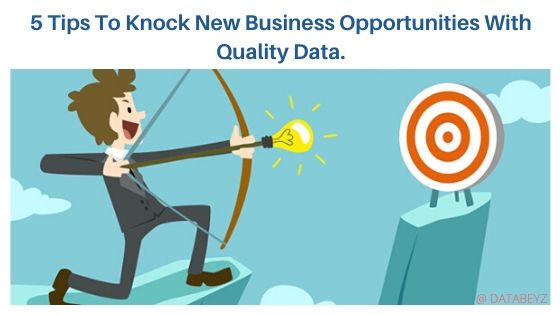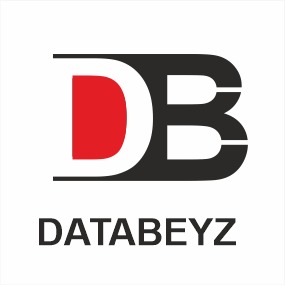5 Tips To Knock New Business Opportunities With Quality Data

Growth of Data
The most precious resource available to marketer’s today is Data, with Data the journey of finding, connecting and growing your customer base starts off. While Data is the lifeline for organizations, regardless of just knowing the basics of Data, people are still unaware of its importance, to gain the maximum benefits.
With the burst of Social Media Platforms, data is growing at an exponential speed. While organizations spend heavily to have efficient systems in-house to capture data points, it is a daunting task to map them through all the channels.
Data is in continuous flux. While we hold data, new data is generated, this data in motion needs to be tracked and mapped throughout the different touch points to have a consistent and updated view of the data. This would eventually result in Quality Data, worthy enough to make informed business decisions.
Few months ago, I came across a senior analyst from a large company. The company he was working for, was facing huge data quality issues. His investigation, on duplicate, incomplete, irrelevant, missing data spanning across multiple touch points, sent him in a dizzy.
Every department was holding records which were duplicate, incomplete and with no relation. Thus resulting in a good collection of data but not good enough to co-relate and infer. It was difficult to derive any business decision with the much needed conviction. This is surely the same case with every other organization when it comes to data quality.
Some Facts About Data
• Gartner's research states, 40% of all business initiatives are failing to achieve their targeted benefits due to poor quality data.
• Lack of Planning and execution phases of normalizing initiatives are the primary cause leading to bad data.
• Due to bad quality data 12% -14% of revenue gets wasted.
• 70% - 80% of businesses assume that unreliable and incomplete information showcases a higher impact on their bottom line.
• Practicing high-quality data can shoot up business sales by 20% - 40%.
Good delivered wrong is no good. How do we ensure Quality Data which would help organization make informed decisions?
Maintaining Quality Data
There are several definitions on quality data but all of them have some pointers co-related to each other. Generally speaking a good quality data communicates productively, evaluating clientele needs and serves it to the best of it, as per data specialists.
Your data owes value only when it supports a business process or powers organizational decision making. This means quality data can be defined as, the proportion of stored data against the potential data (100% up-to-mark).
As the technologies and strategies of data management advances, data continues to benefit the business. Companies are using data which would aid them in decision making strategies.
5 Tips for Maintaining Quality Data
So if you are looking to reap benefits out of your data, then your data must be of high-quality. With these 5 tips you can now build quality data pipeline that can sustain your business growth.
ACCURACY: Does your data reflect your data set?
- Measures are under-taken to sustain data value ensuing accuracy towards the most important data attributes
- An error-free data can connect larger audience.
A contact record containing email address field, needs to ensure that the data in the field is email, something like john@abc.com cannot be represented as an email with just username John. Date representation should be consistent, we cannot have a date field with the format mixed between US & Europe, as the representation would yield different understanding. In USA December 20, 1951 for instance date of 12/20/1951 would be correct as this represents dates in USA format, whereas if you list it as, 20/12/1951 would be considered wrong /inaccurate because this representation is in European format
Accuracy of FORM and CONTENT needs to be disciplined and consistent. But that does not mean the data is accurate, for it to be completely accurate the data also need to be 100% correct.
RELEVANCY
- One relevant information is far better than thousand findings.
- Qualitative /Quantitative aspects of data should be measured as per your goal.
- Relevant data can give rise to successful profits.
Missing records are very difficult to detect. Usually every organization holds master records and sub-records. In this case if a customer has placed an order and completes the purchase based on the invoice you have sent, the update has to be made in the sub-record. If you miss out on updating, the record not only stands incomplete, but you may return to the customer asking for payment. Resulting in confusions and loosing customer’s trust.
COMPLETENESS: Are all your data set update?
- Ensuring there are no gaps.
- Complete customer names, phone numbers, email addresses etc..
- Complete data can improve customer experience.
Customer’s First/Last name is mandatory, but Customer’s Middle name is optional. This still does not make the contact complete, unless mandatory fields are populated. Every value in any field, measure it in terms of validity, existing records, format, data type, ranges, values, (as per defined set of data).
TIMELINESS Time builds credibility.
- Make your data count by keeping it up-to-date with a regular Routine Sanity Check.
- Timely modified data satisfies effective decision making.
Timeliness is measured between the data needed and when it is readily available for use.
If there is an address change of per customer, the new address has also been provided by the customer, but has not been updated in the data records and the billing gets proceeded, this entry falls back of timeliness update check.
VALIDITY: Do your data set match the norms?
- Data should be organized and structured.
- Clean, correct, duplicate-free data.
- Validated data is the new oil that fuels quality data.
Data is not static. Validity is a deep check of how sound your research is. Customer name, contact details, date of birth, company details, email addresses, social profile details, etc… Needs to be validated. Validate data is a vast topic in itself, we shall cover it separately shortly.
Define a data refresh cycle, which you would follow on a regular basis to conduct a thorough analysis of the 5 points mentioned above and purge bad records.
Benefits of Quality Data?
Good data management is pivotal to keep up with the competition and leverage opportunities. Check out potential benefit with quality data:
- Powerful in taking decisions: Advanced data quality draws higher quality results and higher the quality, easy to trust and make decisions.
- Attract niche audience: Data of high-quality means focused, accurate and determined audience. The marketers get acquainted with who their targeted audiences are, this eliminates their guess work and fetches higher ROI.
- Benchmark on content and marketing campaigns : After striking right quality data to right audience, the next step is to prepare contents or ads appealing to them. For example, if you are a publisher of a apparel website, you can gather data that tells you which categories your website users are mostly interested in. If you observe, western outfits is one of your most popular section, you shall update your content team to create articles or videos based on western-outfits related. Same methodology can also be implemented to run email marketing campaigns.
- Enhance relationship with customers: Quality data allows you to deliver up-to-date customer information without duplicating. This in-turn builds a strong-trust bound with them.
- Take advantage of your golden data: High quality data favors more opportunities. Don’t be behind and miss on benefits. Be ahead of your competitors in gaining them.
- Where there is quality, profits are available: With high quality data you can run targeted campaigns and hike up your sales. Everything that’s precious, values the most.
DATABEYZ follows a stringent process of acquiring data and running through different pipelines/stages to keep the data consistent and up to date, verified by a human.
Don’t just set boundaries, out bound them and reach out to us today!! Like, Comment and Share your experience.

